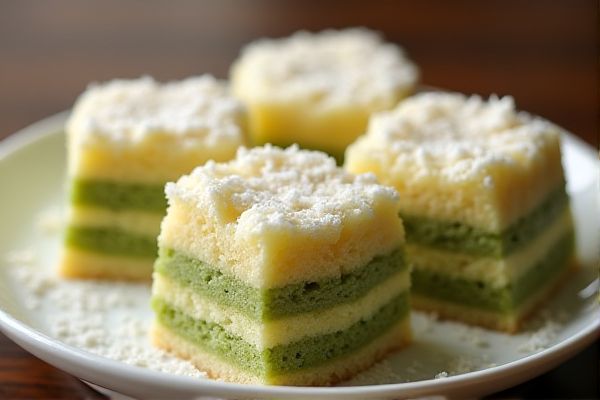
Steamed Malay Cake from Tim Ho Wan features soft, spongy layers infused with fragrant pandan and coconut milk, topped with a light dusting of toasted desiccated coconut, offering a delicate balance of sweet and aromatic flavors.
Equipments
- Mixing bowls
- Whisk
- Sieve
- Measuring cups
- Measuring spoons
- Rubber spatula
- Steamer or steaming pot
- Cake pan or round baking tin
- Parchment paper
- Cooling rack
- Knife (for cutting cake, optional)
- Small frying pan (for toasting coconut, optional)
Ingredients
- 1 cup (125g) cake flour
- 1/2 cup (100g) granulated sugar
- 1/4 teaspoon salt
- 1 teaspoon baking powder
- 2 large eggs
- 3/4 cup (180ml) coconut milk
- 1/4 cup (60ml) pandan juice or pandan extract
- 2 tablespoons vegetable oil
- 1/4 teaspoon vanilla extract
- 1/4 cup (20g) desiccated coconut
Using fresh pandan juice or high-quality pandan extract is crucial to achieving the authentic aroma and vibrant green hue characteristic of Steamed Malay Cake. Opt for full-fat coconut milk instead of light versions to ensure a rich, creamy texture and enhanced coconut flavor. Measure the cake flour carefully and sift it to prevent lumps and maintain the cake's soft, spongy layers. Toasting the desiccated coconut in a small frying pan before topping adds a delightful crunch and boosts the nutty aroma that complements the sweet and aromatic flavor profile. Your steamed Malay cake will closely mimic the Tim Ho Wan copycat menu by attentively balancing these key ingredient qualities.
Instructions
- Prepare cake pan: Line cake pan with parchment paper.
- Toast coconut: Lightly toast desiccated coconut in a small frying pan until golden; set aside.
- Sift dry ingredients: Sieve cake flour, baking powder, and salt into a mixing bowl.
- Mix wet ingredients: In another bowl, whisk eggs, sugar, coconut milk, pandan juice, vegetable oil, and vanilla extract until well combined.
- Combine ingredients: Gradually fold wet mixture into dry ingredients using a rubber spatula until smooth and lump-free.
- Pour batter: Transfer the batter into the prepared cake pan.
- Steam cake: Place cake pan in steamer or steaming pot over boiling water, cover, and steam for 30–35 minutes or until a skewer inserted into the center comes out clean.
- Cool: Remove cake from steamer and transfer to cooling rack; let cool slightly.
- Top cake: Sprinkle toasted desiccated coconut evenly over the top of the cake.
- Slice and serve: Cut cake into portions and serve warm or at room temperature.
Substitution
Steamed Malay Cake from Tim Ho Wan copycat menu captures the signature softness and fragrant pandan-coconut flavor of the original dessert. If pandan juice is unavailable, use pandan extract diluted in water as a convenient alternative without compromising the aroma. Coconut milk can be substituted with full-fat coconut cream mixed with water to maintain the rich texture. Adjust steaming time if you use silicone or metal cake pans, as heat distribution varies slightly between materials. Toasting desiccated coconut in a dry pan enhances flavor but can be skipped if you prefer a milder finish on your cake.
Tips
Ensure your steaming pot has enough boiling water before placing the cake pan inside to maintain consistent steam throughout the cooking process. Avoid opening the steamer lid frequently during steaming to prevent heat loss, which can affect the cake's texture and rise. Use a skewer or toothpick to test doneness; insert it into the center, and if it comes out clean, the cake is ready. When folding wet and dry ingredients, gently incorporate to keep your Steamed Malay Cake soft and spongy without deflating the batter.
Nutritions
Steamed Malay Cake from Tim Ho Wan combines ingredients like coconut milk and pandan juice, which provide essential nutrients such as healthy fats and antioxidants. The cake flour offers carbohydrates for energy while eggs contribute high-quality protein and vital vitamins like B12 and D. Toasted desiccated coconut adds fiber and minerals such as manganese, enhancing digestion and bone health. Your serving delivers a balanced mix of macronutrients and aromatic flavors without excessive sugar, making it a moderately nutritious treat.
Storage
Store your Steamed Malay Cake in an airtight container at room temperature for up to two days to maintain its soft, spongy texture. For longer storage, refrigerate wrapped tightly in plastic wrap or aluminum foil for up to one week, ensuring the cake doesn't dry out. Reheat gently by steaming before serving to restore the moist, fragrant flavors and aroma.
Variation or Alternatives
You can substitute cake flour with all-purpose flour combined with 1 tablespoon of cornstarch to maintain a tender crumb. For a richer aroma, try adding 1/2 teaspoon of coconut extract alongside the pandan juice. Instead of steaming, baking the cake in a water bath at 325degF (163degC) for about 40 minutes creates a similar moist texture. Toasting the desiccated coconut with a pinch of salt can enhance the contrast between sweet and savory notes.
Allergies
Steamed Malay Cake from Tim Ho Wan contains eggs and coconut milk, common allergens that may cause reactions in sensitive individuals. The presence of desiccated coconut also poses a risk for those allergic to tree nuts or coconut specifically. You should exercise caution if you have any known allergies to these ingredients to avoid adverse effects.
Why this recipe?
Steamed Malay Cake from Tim Ho Wan restaurant delights with its soft, fragrant texture and subtly sweet coconut flavor that perfectly balances each bite. People enjoy this traditional delicacy for its light, fluffy consistency and authentic ingredients that offer a genuine taste of Southeast Asian dessert culture. Making the copycat version allows you to recreate the restaurant's signature treat at home, ensuring freshness and customization to your preference. Your effort to replicate this beloved dish captures the essence of Tim Ho Wan's culinary craftsmanship and satisfies cravings without the wait.
